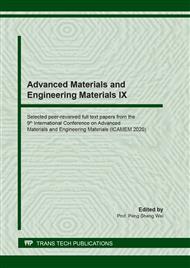[1]
X. Duan, Y. Huang, R. Agarwal, C.M. Lieber, Single-nanowire electrically driven lasers, Nature 421 (2003) 241–245.
DOI: 10.1038/nature01353
Google Scholar
[2]
J.S. Xu, D.F. Xue, Fabrication of malachite with a hierarchical sphere-like architecture, J. Phys. Chem. B 109 (2005) 17157–17161.
DOI: 10.1021/jp052864i
Google Scholar
[3]
J. Goldberger, R. He, Y. Zhang, S. Lee, H. Yang, H.-J. Choi, P. Yang, Single-crystal gallium nitride nanotubes, Nature 422 (2003) 599–602.
DOI: 10.1038/nature01551
Google Scholar
[4]
S. Piana, M. Reyhani, J.D. Gale, Simulating micrometre-scale crytal growth from solution, Nature 438 (2005) 70–73.
DOI: 10.1038/nature04173
Google Scholar
[5]
S. Zhu, H. Zhou, M. Hibino, I. Honma, M. Ichihara, Synthesis of MnO2 nanoparticles confined in ordered mesoporous cabon using a sonochemical method, Adv. Funct. Mater. 15 (2005) 381–386.
DOI: 10.1002/adfm.200400222
Google Scholar
[6]
D.-F. Zhang, H. Zhang, L. Guo, K. Zheng, X.-D. Han, Z. Zhang, Delicate control of crystallographic facet-oriented Cu2O nanocrystals and the correlated adsorption ability, J. Mater. Chem. 19 (2009) 5220–5225.
DOI: 10.1039/b816349a
Google Scholar
[7]
C.-H. Kuo, Y.-C. Yang, S. Gwo, M.H. Huang, Facet-dependent and Au nanocrystal-enhanced electrical and photocatalytic properties of Au-Cu2O core-shell heterostructures, J. Am. Chem. Soc. 133 (2011) 1052–1057.
DOI: 10.1021/ja109182y
Google Scholar
[8]
C.-H. Kuo, M.H. Huang, Fabrication of truncated rhombic dodecahedral Cu2O nanocages nanoframes by particle aggregation and acidic etching, J. Am. Chem. Soc. 130 (2008) 12815–12820.
DOI: 10.1021/ja804625s
Google Scholar
[9]
A.O. Musa, T. Akomolafe, M.J. Carter, Production of cuprous oxide, a solar cell material, by thermal oxidation and a study of its physical and eletrical properties, Sol. Energ. Mat. Sol. C 51 (1998) 305–316.
DOI: 10.1016/s0927-0248(97)00233-x
Google Scholar
[10]
J. Zhang, J. Liu, Q. Peng, X. Wang, Y. Li, Nearly monodisperse Cu2O and CuO nanospheres: Preparation and applications for sensitive gas sensors, Chem. Mater. 18 (2006) 867–871.
DOI: 10.1021/cm052256f
Google Scholar
[11]
B. White, M. Yin, A. Hall, D. Le, S. Stolbov, T. Rahman, N. Turro, S. O'Brien, Complete CO oxidation over Cu2O nanoparticles supported on silica gel, Nano Lett. 6 (2006) 2095–(2098).
DOI: 10.1021/nl061457v
Google Scholar
[12]
M. Yang, H.P. You, Y.H. Zheng, K. Liu, G. Jia, Y.H. Song, Y.J. Huang, L.H. Zhang, H.J. Zhang, Hydrothermal synthesis and luminescent properties of novel ordered sphere CePO4 hierarchical architectures, Inorg. Chem. 48 (2009) 11559–11565.
DOI: 10.1021/ic901829v
Google Scholar
[13]
R. Jana, A. Dey, M. Das, J. Datta, P. Das, P.P. Ray, Improving performance of device made up of CuO nanoparticles synthesized by hydrothermal over the reflux method, Appl. Surf. Sci. 452 (2018) 155–164.
DOI: 10.1016/j.apsusc.2018.04.262
Google Scholar
[14]
Joint Committee on Powder Diffraction Standards (JCPDS). Powder Diffraction File, Card No.005-0661, Swarthmore, PA.
Google Scholar
[15]
W.X. -Bo, H.L. -Nan, A novel one-step method to synthesize copper nitrate hydroxide nanorings. Trans. Nonferrous Met. Soc. China 19 (2009) s480–s484.
DOI: 10.1016/s1003-6326(10)60093-3
Google Scholar
[16]
Joint Committee on Powder Diffraction Standards (JCPDS). Powder Diffraction File, Card No.015-0014, Swarthmore, PA.
Google Scholar
[17]
F. Wu, F. Cao, Q. Liu, H. Lu, L. Li, Enhancing photoelectrochemical activity with three-dimensional p-CuO/n-ZnO junction photocathodes, Sci. China Mater. 59 (2018) 825–832.
DOI: 10.1007/s40843-016-5054-6
Google Scholar
[18]
P. Pookmanee, P. Sangthep, J. Tafun, V. Kruefu, S. Kojinok, S. Phanichphant, Synthesis, characterization and its photocatalytic of copper oxide (CuO) powder, Mater. Sci. Forum 962 (2019) 70–76.
DOI: 10.4028/www.scientific.net/msf.962.70
Google Scholar
[19]
C. Sarkar, S.K. Dolui, Synthesis of copper oxide/reduced graphene oxide nanocomposite and its enhanced catalytic activity towards reduction of 4-nitrophenol, RSC Adv. 5 (2015) 60763–60769.
DOI: 10.1039/c5ra10551j
Google Scholar
[20]
D.P. Dubal, G.S. Gund, C.D. Lokhande, R. Holze, CuO cauliflowers for supercapacitor alication: Novel potentiodynamic deposition. Mater. Res. Bull. 48 (2013) 923–928.
DOI: 10.1016/j.materresbull.2012.11.081
Google Scholar


